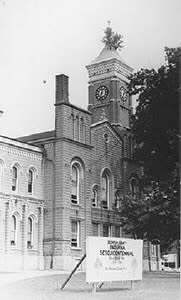About Greensburg

In 1819, through the Indian Treaty of St. Mary's, the U.S. Government acquired a tract of land known as the New Purchase. Soon after this, the John Fugit & Griffy Griffith families entered the region, becoming the first settlers of the county. The area comprising Decatur County was set off from this tract in 1821 and named for Commodore Stephen Decatur, a naval hero. In April 1822 the court was established and the government was set up in May. The site of the county seat was chosen in June 1822 and named, Greensburg by Thomas Hendricks' wife, for her home in Pennsylvania. The first county building was a jail built in 1823 on the southeast corner of the courtyard. According to the Society of Indiana Pioneers, an individual was a pioneer of our county if they resided here on or before December 31, 1830.
Early in the 1870s, citizens noticed what seemed to be a small sprig on the northwest corner of the Courthouse tower, Soon it became evident that the small sprig was growing. Residents regarded the growth as a rare freak of nature. That explanation was quickly refuted by the appearance of more sprouts on the tower. Finally, five were counted, making a grove growing at an altitude 110 feet above the courthouse lawn level.

County officials became fearful the trees might cause permanent damage to the tower roof. In 1888, a steeplejack was employed to help workers ascend the building and remove some of the shrubs. Of the two remaining, one attained a height of about 15 feet diameter of almost five inches at the base. At the same time, another tree made an appearance on the southeast corner of the tower, and in a few years grew to a considerable height. During its maturation, another tree sprung up on the southwest corner. These two new trees endured, as did the county's legacy as the home of the Courthouse tree.
The first Courthouse in Decatur County was actually a home. On May 14, 1822, when the first board of county commissioners met at the house of Thomas Hendricks. a double log building, the records show the specification that were drawn up for a proposed Courthouse. On March 7, the order was issued to receive bids for the construction of the Public Square in Greensburg.
Several different buildings were there until the current structure was built in 1860. In 1994, a major renovation and expansion at the north end, more than doubled the size of the facility. At that time, the decision was made to replace the existing stucco exterior with brick, which was also the original outer material.

It was on the Courthouse lawn that brave men camped out to defend their families from threats of a possible attack by Morgan's Raiders during the Civil War.
On the grounds of the courthouse are a number of markers and monuments, including a monument to the soldiers of the Civil War and a memorial elm to the local corps of the G. A. R. Both of these were placed by the local chapter of the W. R. C. The local chapter of the D. A. R. erected a boulder with a tablet honoring Colonel Thomas Hendricks, the city's founder. Another boulder with a bronze tablet contains a replica of the Maltese cross, dedicated to the memory of the Spanish War veterans. In the corridor of the building is a bronze tablet dedicated to the man for whom the county was named.
The Decatur County Historical Museum stands in Greensburg. Built-in 1835, it was sold to the Historical Society in 1981 to be used as a county museum. The museum is open to the public, once a week.
Andrew Carnegie provided money for public use for 3,000 communities nationwide. One type of project it funded was responsible for constructing libraries. Greensburg was one of those communities. The library was opened in 1905 and was built on the site of the Watson Foundry where much of the decorative ironwork in Greensburg was made.
In 1994, the Greensburg/Decatur County Contractual Public Library moved out of its building for a larger facility on East Main Street. The city made renovations to the building, transforming the former library into a comfortable home for the city government. The most noticeable feature retained from the old Carnegie Library was the rotunda ceiling, which includes portraits of past heroes of arts and letters: Homer, Raphael, Noah Webster, William Cullen Bryant, William Shakespeare, Friedrich Von Schiller, Henry Wadsworth Longfellow, and Ludwig Van Beethoven.
The city of Greensburg, with a population of 10,260, is forty-seven miles southeast of Indianapolis. A railroad and bus line provide the chief transportation facilities. Among the city's products are flour, carriages, lumber, iron castings, auto accessories, caskets, hardware, brooms, wire, and shirts. The city has purchased the Greensburg Water Company.
Greensburg has a new federal building and post office, a community gymnasium that seats 4,000; a National Guard Armory; a Y. M. C. A. which is one of the finest in Indiana, built through the munificence of the late Nelson Mowrey, who gave the institution $175,000; and the Decatur Memorial Hospital erected by the county at a cost of over $100,000. The Indiana State I. O. O. F. Home is located to the east of the city.
In 2006, The City of Greensburg moved its City Hall from its location on Michigan Street to its new offices located at 314 West Washington Street.
On June 13-20, 2009 The City of Greensburg celebrated its Sesquicentennial!
